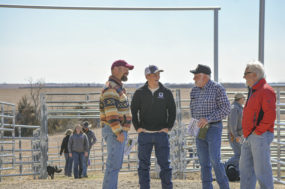- Chicken product was viewed slightly more favorably than beef, but attitudes toward production practices were about the same for both.
- Beef consumers are most concerned with antibiotics/hormones, diseased/sick cattle, inhumane treatment/crowding, slaughtering methods and feed rations.
- Chicken consumers are most concerned with overcrowding in production “factories,” salmonella/sickness, unsanitary processing and antibiotic/hormones.
- More consumers now acquire and are sharing information on meat production and are more active in taking action based on information.
- Favorability among the general public toward cattle ranchers is becoming closer to the high favorability of primary beef consumers.
- Mention of “feedyards” reduces favorability.
- For information on production practices, ranchers have higher credibility than dietitians.
- The beef industry is seen as stronger and more stable than chicken for “ongoing programs to produce the most nutritious meat possible.”
- Positive perceptions result from messages conveying that beef can decrease cholesterol, contains vital minerals, is protein rich, helps preserve wildlife space and is now leaner.
- Most consumers are comfortable with treating sick cattle with antibiotics when supervised by a veterinarian under prescribed guidelines.
Reuse of CIDR inserts for artificial insemination
Controlled internal drug release (CIDR) inserts (nylon coated with silicone) are used in many heat synchronization procedures to infuse progesterone. One-time use of inserts increases cost of these procedures. Prior research investigated subjecting used inserts to autoclaving, a process employing heat, steam and pressure. Autoclaved inserts yielded similar results to new inserts.
Autoclaves are not commonly available to most producers, so some have used other methods in an attempt to sterilize and reuse inserts. A study was conducted to examine some of these methods.
New CIDR inserts were compared to previously-used, washed, disinfected, air-dried CIDR inserts that were then either autoclaved, processed in a dishwasher, microwaved, heated in a toaster oven, run through a clothes dryer, boiled in water, stored outdoors for 60 days or not processed.
Six months later, all inserts were placed in prepubertal heifers. Blood samples were taken, to measure levels of progesterone, immediately before insertion, three hours after insertion and daily for the 11 days before inserts were removed.
Throughout the 11 days, there were no significant progesterone differences among unprocessed and the heat-processed treatments (dishwasher, microwave, oven, clothes dryer or boiling). Inserts stored outside for 60 days tended to be lowest throughout. From three hours to day three, autoclaved had highest levels followed by new inserts; beyond day three, new inserts had highest levels.
The authors made no recommendations based on their data, except to say that “any potential issues that may arise with inserting contaminated used CIDR inserts are avoided when new inserts are used.” Note: New inserts are labeled for single use.
Proposed changes in Texas trich reglations
The Texas Animal Health Commission (TAHC) has proposed changes to the rules for trichomoniasis testing as follows:
- Add testing requirements for a herd of origin when a bull from the herd is sold and subsequently found to be infected with trich.
- Require testing when a bull is separated from its unit of origin, such as when a bull is found on property not owned by the owner or caretaker of the bull (stray), and that bull is found to be infected with trich. Under the proposal, the pasture (unit) of origin and pasture where the stray trich bull was located will both be placed under hold order, and any additional bulls located there must be tested for trich.
- Allow TAHC to evaluate the effectiveness of a herd control plan for an infected herd leading to the possible continuation or disapproval of the herd plan based on the progress or lack of progress made in controlling the disease within the herd.
- Finally, the proposal would require herds enrolled in the Trich Herd Certification Program to have perimeter fences that are adequate to prevent the ingress or egress of cattle.
Effect of monesin and growth implant for stockers
Preconditioned steers initially averaging 524 pounds were grazed on wheat pasture in two successive years. Stocking rate from mid-November to mid-February (fall) was 1 acres per steer, and rate from mid-February to late April or early May (spring) was 0.5 acres per steer.
Steers received free-choice non-medicated mineral, mineral with monensin or protein block with monensin; in addition, half of each group was implanted with trenbolone acetate/estradiol/tylosin (Component TE-G with Tylan; Elanco Animal Health) and half of each group was not implanted.
Both methods of delivering monensin significantly increased gain, by 0.15 pounds per day in mineral or 0.20 pounds per day in blocks; differences between delivery methods were not statistically significant. Implanting significantly increased gain, by 0.31 pounds per day.
Net return per steer was evaluated by analyzing differences assuming three different values for weight gain. Both monensin supplementation and implanting significantly increased net return at all values for gain. Supplement cost was higher for blocks so, compared to block, the mineral method of providing monensin significantly increased net return at low and intermediate values for gain and tended to do so at higher values for gain.
At lower values for gain, mineral monensin with the implant increased net return by $30 per head, and block monensin with the implant increased by $18 per head; at higher values for gain, the respective increases were $54 per head and $43 per head.
Do rest stops affect stress and performance?
Angus-Hereford crossbred, weaned, preconditioned steers and heifers averaging 503 pounds were either hauled nonstop for 800 miles, or hauled 800 miles with two rest stops approximately every 270 miles.
Hauling of the rest group started four hours before the nonstop group (6 a.m. versus 10 a.m.) to arrive at the same time (10 a.m.) the next day. At both rest stops, cattle were unloaded for two hours and allowed access to water and mixed grass-alfalfa hay. Individual blood samples were taken before hauling commenced (day zero), upon arrival (day one) and on days four, seven, 14, 21 and 28.
From the time hauling commenced to when cattle were unloaded, weight shrink was lowest for rest and highest for nonstop. Plasma indicators of stress were higher for nonstop upon arrival but not later. Feed consumption, feed efficiency and ADG did not significantly differ over the 28 days after arrival.
The authors concluded that rest stops during hauling reduced some indicators of short-term stress but did not affect early feeding performance
Effect of varying nutrition on heifer development
Heifers of one-half Angus, one-fourth Hereford and one-fourth Brahman breeding were weaned at the average age of 109 days and assigned to one of four groups:
- Group 1 had restricted consumption of forage-based diet to gain 1.1 pounds per day to 14 months of age.
- Group 2 had controlled consumption of high concentrate-based diet to gain 2.2 pounds per day to 14 months of age.
- Group 3 had free-choice consumption of high-concentrate diet to 6 1/2 months of age, followed by restricted consumption of forage-based diet to 9 months of age (to achieve ADG of 0.75 pounds per day), followed by free-choice consumption of high-concentrate diet until 11 1/2 months of age, followed by restricted consumption of forage-based diet (to achieve ADG of 0.75 pounds per day) to 14 months of age.
- Group 4 had reverse sequence of Group 3, beginning with restricted consumption of forage-based diet instead of high-concentrate diet.
Heifers were weighed every two weeks, and blood was sampled twice weekly beginning at 8 months of age to assess progesterone as a measure of puberty.
Overall ADG was significantly different among all groups with Group 1 at the lowest and Group 4 at the highest. Percent puberty in Group 1 was lower throughout the study. Puberty in Group 4 was lower at 12 months of age than Groups 2 and 3, which did not differ. However, by 14 months of age there was no difference in puberty among Groups 2, 3 and 4.
The authors noted that the regimen used in Group 4 could be optimum, resulting in high rates of puberty by 14 months of age while “avoiding high incidence of precocious puberty” at younger ages.
The 60th Annual Texas A&M Beef Cattle Short Course
The 60th Annual Texas A&M Beef Cattle Short Course (TAM BCSC) will be held on the campus of Texas A&M University on Aug. 4-6, 2014. The TAM BCSC is the largest beef educational event in the country. It is a three-day seminar that represents the culmination of knowledge from industry leaders and experts.
Each year more than 1,300 beef producers and enthusiasts attend the TAM BCSC to expand their knowledge of the beef cattle industry and join in the discussion of the most current issues facing the producer. This industry gathering features the popular Cattleman’s College, a general session with the nation’s leading beef cattle experts, seminars, workshops and hands-on demonstrations.
To obtain more information and register go to the TAM BCSC website. ![]()
Stephen Hammack, Ph.D., is professor and extension beef cattle specialist emeritus at Texas A&M University. This originally appeared in the Beef Cattle Browsing newsletter.
References omitted but available upon request. Email editor@progressivecattleman.com.







